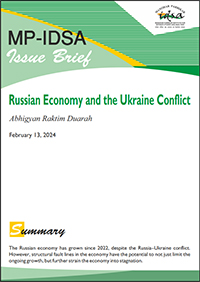Russian Economy and the Ukraine Conflict
- February 13, 2025 |
- Issue Brief
Summary
The Russian economy has grown since 2022, despite the Russia–Ukraine conflict. However, structural fault lines in the economy have the potential to not just limit the ongoing growth, but further strain the economy into stagnation.
Major changes have occurred in the Russian economy since the initiation of the Russia–Ukraine conflict. Analysts note that spending on infrastructure has become the main driver of growth.[1] There have been substantial increments of household spending within different regions. Olga Belenkaya, head of macroeconomic analysis at Moscow-based brokerage Finam states that families with previously low incomes, are, at present, increasing their demand for durable goods, including cars, home repairs, tourism and dining.[2]
The spending in this scenario indicates a direct correlation to the increasing real salaries over various domestic sectors, with blue and white-collared workers gaining ‘winning’ benefits from the situation. For instance, whilst the nominal increase within the first few months of 2024 has been around 20 per cent year-on-year, long-distance truck drivers now get an average of 180,000 rubles a month (~ 38 per cent year-on-year).[3]
A key driver in Russia’s economic growth since the conflict has been the increase in its public spending, which includes military as well as other types of public spending. For instance, in 2022, consolidated public expenditure rose 17 per cent, compared to 2021.[4] Nominal spending grew faster than inflation, displaying a clear increase in real expenditures as such. A similar pattern is observed in 2023, when Russia spent 32.36 trillion rubles (on the current rate), an amount up by 4 per cent from 2022, with a significant amount being allocated for military requirements (over 6 trillion rubles).[5] The budget deficit created by such increased spending, which stood at around 2 per cent of GDP both in 2022 and 2023, was subsequently met by borrowings from the National Welfare Fund (NWF), Russia’s reserve fund where oil revenues are deposited to finance pensions and infrastructure. Over the whole of 2023, Russia withdrew around 2.9 trillion rubles from NWF.[6]
As such, the Russian economy has been resilient. Furthermore, the following factors have also played a part in aiding this resilience.
- The gaps in the existing sanctions regime, particularly for the European Union, which had required time to find alternative oil suppliers;[7]
- Second, increasing energy prices partially offset the effects of the conflict as well as the sanctions by substantially increasing the foreign currency inflows;
- Third, the Russian economy learnt from its experiences with past sanctions post-Crimean crisis, by introducing policy measures (including reinstating fiscal rules and investing in domestic financial market infrastructure), thereby shielding the economy from sudden shocks;[8]
- Fourth, partnership with ‘friendly countries’ (particularly India and China) which helped Russia gain access to markets for energy exports; Russia also increased its economic engagements with Southeast Asia as well as Africa.[9]
Fault Lines in Russian Economy
Despite the resilience of the Russian economy, it is pertinent to highlight some fault lines which have gained prominence since the initiation of the Ukraine conflict.
Oil and Gas: Uncertainty regarding Exports
The first fault line relates to constraints experienced on production and exports of energy resources, particularly from 2023 post implementations of energy sanctions. While several countries, including the US and the UK, banned Russian oil and gas in 2022, energy sanctions began to materialise by 2023, with EU embargo and G7 price caps on oil (at US$ 60 per barrel) and petroleum products.[10] These sanctions aimed towards eroding economic stability, triggering policy trade-offs, and changing Russia’s calculus regarding future conflicts.[11]
Whilst the Russia–Europe gas relationship has been underpinned by cooperation based on mutual benefits (with Gazprom monopolising much of the supply of pipeline gas to the EU), the hasty separation has imposed a subsequent toll on both sides, especially on Russia. In 2021, Russia accounted for 42 per cent of European imports of natural gas. By 2023, the number had fallen to 14 per cent, with the EU cutting down the deliveries of Russian pipeline gas by 80 per cent.[12] As a result, a major impact has been observed on Gazprom’s results, with revenues falling up to 30 per cent, and a net loss of 640 billion rubles (~ US$ 6.9 billion) since the initiation of the conflict.[13]
Amidst such chaos, Russia’s ‘Pivot to Asia’ is garnering significance, with the Power of Siberia pipeline slowly reaching its peak of 38 bcm. The Power of Siberia 2 (SP-2) pipeline has become a pressing agenda in Moscow–Beijing relations. However, the prime issue with this pivot is the nature of the product being delivered—gas, unlike oil, requires critical technologies, as well as infrastructure (dedicated pipelines, LNG terminals, ice-breakers, etc.). These are, at present, substantially lacking within Russia’s Far East.[14]. At the same time, the pipeline element seemingly focuses on one country (China). This leaves Gazprom exposed to commercial risks, as well as Russia susceptible to Beijing’s interests, which has created concern in the limelight of Beijing’s scant interest in SP-2, and their tight purchase demands.[15]
A similar case is observed with Russia’s oil exports, where the current scenarios within the international oil market mark certain oscillating trends—the Russian economic recession period correlating with the oil price distress, and the oil price growth corresponding with the increase in Russian GDP.[16] For instance, in 2023, whilst having a delayed market response to heightened oil prices in 2022 (with Brent crude reaching US$ 139/ barrel), the Russian economy indeed acquired a rebound, substantially driven by the profits to the base oil revenues, with little extraordinary revenues generated.
However, budget revenues from exports observed a deduction of 55–58 per cent in the first two quarters of 2023,[17] when the average Ural blend plummeted to US$ 62.99, 1.2 times lower than the 2022 average.[18] This comes as a result of the economy being over dependent on one particular sector, thereby making it vulnerable to fluctuations. In fact, at present, Saudi Arabia’s plan to increase oil production to regain lost markets could further pose substantial risks to Russia’s state revenue. Even a US$ 20 price fall in oil prices would lead to 1.8 trillion rubles (US$ 20 billion) fall in revenue, an equivalent to 1 per cent of Russia’s GDP.[19]
Labour Issues
Second, whilst the increase in household spending indicates a substantial increase in the salaries of workers (as discussed previously), the correlation of the same with the macroeconomic performance of the state doesn’t necessarily display a positive outlook. For one, whilst wages observe consistent increment when the economy becomes sophisticated (higher public investments, consequently increasing labour productivity), substantial increment in wages is a result of lower unemployment and tighter labour markets, as the Phillips curve states.[20]
Russia’s situation seemingly appears to delve in a similar direction. By June 2024, the unemployment rate had plunged to a mere 2.4 per cent, an all-time low.[21] At the same time, the number of job openings was reported to be 2.1 million, along with substantial increase of monthly wages by May 2024 to 86,384 rubles, displaying an increment of 18 per cent from May 2023.[22] The tightening labour market within the Russian economic structure as such has now become a matter of significant crisis. The shortages of workers is depicted by rising vacancies, where the ‘practically exhausted’ labour reserves now are unable to meet the demands of economic requirements,[23] driving the production capacities to near exhaustion by fuelling inflation to ever higher rates.
The shortfall is further exacerbated by the dwindling labour supply. Presently, the labour supply has constantly been observing a decrease, prying to three particular rationales that have tightened the issue. First, Russia’s negative population growth has lowered its availability of reserved human resources. Child births since 2016 have observed a significant decline, with fertility rates in 2023 being around 1.4, which does not ensure population replacement (which requires 2.15).[24] At the same time, the ageing societal shifts of the population have further diluted youth presence within the workforce, a crucial resource required when the economy is returning towards labour-intensive technologies that require healthy individuals for maintenance and functioning.[25]
Second, Russia’s labour regime has observed a negative net migration of workers (with most workers coming from remittance-dependent post-Soviet states),[26] which has now hampered the naturalisation process of labour compensation. The negative trends, driven by the COVID-19 pandemic, have now acquired concerning numbers due to the ongoing conflict. According to Rosstat, the number of migrants entering Russia in 2023 reached 560,400, 23 per cent lower than a year earlier. To much dismay, the contemporary situation seemingly continues to procure a further downward trend, following the tightened regulations, xenophobic hostilities, and subsequent political reactions from post-Soviet states, after the terrorist attack at Crocus City Hall in March 2024.[27]
Third, the mobilisation undertakings were initiated to meet the manpower requirements within the defence sector, thereby stimulating absorption from the reserved labour force. With the government’s measures to increase mobilisation since 2022, particularly using contract-based soldiers whilst pushing forward the reservist age limit for compulsory mobilisation from 18–27 years to 30 years, more workers are now being absorbed into the military. Drafts in spring 2024 reached 150,000, the highest since 2016.[28] Aversion of skilled and unskilled workers has further heightened the gravity of the situation, with some estimates citing 800,000–900,000 migrants leaving Russia by 2023.[29] Such outflow does indicate a certain dent in the supply of labour reserves, though statistics vary considerably due to uncertainty.
Conclusion
The substantial pressure on the Russian economy, at large, is due to a declining workforce funnelled with a low unemployment rate. The tight labour market as such, inherently, has led to a substantial increase in inflation. The success of national projects, including project ‘Personnel’ proposed in 2024, seems rather unclear, given the ever-increasing demand for labour in defence and military, further fuelled into question by declining demographic statistics, and lowered migrations.[30]
Investments, following a similar suit, have observed a certain decrease in its influence of enhancing domestic capital flows. Underinvestments have now become prominent, a chronic problem that Russia has been facing for a long time now. With the energy sector acquiring substantial domestic investments due to its importance within the Russian economy, other sectors, particularly manufacturing sectors, have remained underinvested. Access to foreign markets and investments has become difficult, and without the acquisition of Western investments (to which the Russian industry remained substantially dependent), misallocation of resources as well as lowered productivity of manufactured goods becomes a concerning issue in the long run.
The Ukraine conflict highlights the structural issues that the Russian economy has been facing. The critical issues of labour displacement of subsequent shortage, overdependence on limited revenue-generating sectors, and instability of macroeconomic structures to support domestic demands thereby pushing in import substitutions indicate the cooling down of growth for Russia. The continuation of these trends could provoke certain instabilities within the functioning of the economy at large. This gets further problematised by limited foreign investments (particularly Western), as well as constant tightening of monetary policies (increasing key interest rates, ending mortgage subsidies programme, among others).
Surely, Russia’s economic performance has defied all predictions, and substantially provided revenues that have pushed its economic growth to unprecedented levels. However, Russia’s structural constraints would continue to play their part in undermining Russia’s economic growth overall. Any chance for a total economic collapse, however, is unlikely.
Views expressed are of the author and do not necessarily reflect the views of the Manohar Parrikar IDSA or of the Government of India.
[1] Heli Simola, “Russia’s Wartime Investment Boom”, Bank of Finland Institute for Emerging Economies (BOFIT), 15 May 2024.
[2] “Russia’s Surprising Consumer Spending Boom”, Financial Times, 26 July 2024.
[3] Ekaterina Kurbangaleeva, “Russia’s Soaring Wartime Salaries are Bolstering Working-Class Support for Putin”, Carnegie Politika, 28 May 2024.
[4] “Russian Economy on War Footing: A New Reality Financed by Commodity Exports”, CEPR, 24 May 2024.
[5] Pierre-Marie Meunier, “Russia is on a Slow Path to Bankruptcy, But How Slow?”, War on the Rocks, 11 September 2024.
[6] Ibid.
[7] Stefan Hedlund, “The Disillusionment and Hope of Western Sanctions Against Russia”, GIS Reports, 16 April 2024.
[8] “Russian Economy on War Footing: A New Reality Financed by Commodity Exports”, no. 4.
[9] Vaibhav Raghunandan, “Monthly Analysis of Russian Fossil Fuel Exports and Sanctions”, CREA, 20 June 2024.
[10] “Russia’s War on Ukraine: A Sanctions Timeline”, PIIE, 31 December 2023.
[11] Ibid.
[12] “The Future of Russian Gas in the EU”, Real Instituto Elcano, March 2024.
[13] “Russia’s Gazprom Net Losses Nearly Double Year on Year”, The Kyiv Independent, 31 July 2024.
[14] Ibid.
[15] Isabel Stagg, “Russia-China Gas Pipeline Deal Halts Over Beijing’s Price Demands”, World Pipelines, 3 June 2024.
[16] Kristina Tiron and Ayaz Zeynalov, “Macroeconomic Performance of Oil Price Shocks in Russia”, 30 November 2022.
[17] Vladimir Milov, “OIL, GAS, AND WAR: The Effect of Sanctions on the Russian Energy Industry”, Atlantic Council, May 2024.
[18] “Average Urals Price was $62.99 per barrel in 2023, which is 1.2 times lower than in 2022”, TASS, 9 January 2024.
[19] “Putin’s War Economy Faces Pain if Saudis Sink Global Oil Prices”, Politico, 3 October 2024.
[20] Kevin D. Hoover, “Phillips Curve”.
[21] “Russian Unemployment Falls to Record Post-Soviet Low”, BOFIT, 2 August 2024.
[22] Ibid.
[23] “Statement by Bank of Russia Governor Elvira Nabiullina in Follow-up to Board of Directors Meeting”, CBR, 26 July 2024.
[24] Katarzyna Chawryło, “Short-term Stability and Long-term Problems. The Demographic Situation in Russia”, OSW, 3 July 2024.
[25] Vladimir Gimpelson, “’The Russian Model’ in Search of Unemployment”, Re-Russia, 24 April 2024.
[26] Rajoli S. Jayaprakash, “Steady, but Evolving: An Overview of Russia’s Migrant Labour Market”, Observer Research Foundation, 29 April 2024.
[27] “Has the Moscow Attack Made Russia More Xenophobic?”, The Moscow Times, 5 April 2024.
[28] Margaret Klein, “How Russia is Recruiting for the Long War”, SWP, 27 June 2024.
[29] “Escape from War: New Data Puts the Number of Russians Who Have Left at More Than 800,000 People”, Re-Russia, 28 July 2023.
[30] Heli Simola, “Long-term Challenges to Russian Economic Policy”, Econstor, 30 November 2021.





